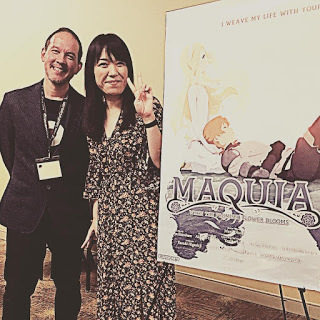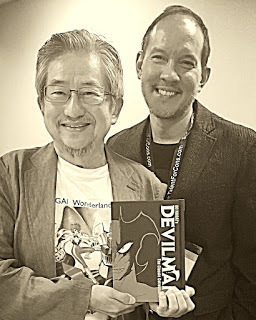Roland Kelts's Blog, page 20
November 4, 2018
Manga & anime in Japan's Heisei era (1989 - 2019)
Defining the Heisei Era: When anime and manga went global
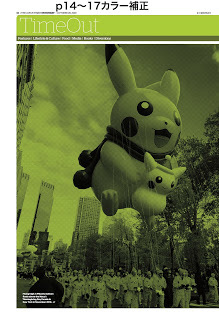
The Heisei Era commenced after two gods fell in rapid succession. The first, Emperor Hirohito, was no longer officially a god, having repudiated his quasi-divine status under the terms of Japan’s surrender in World War II, but he remained god-like in stature. His January death in 1989 at age 87 signaled the end of a Showa past both turbulent and glorious. It drew global attention from the world’s leaders and media, but had been widely anticipated in Japan.
The other fell just one month later, in February, and his death shocked the nation. Osamu Tezuka, the beloved “god of manga,” died of stomach cancer at the age of 60. News of his declining health had been kept secret, as was then customary in Japan. Tezuka was a prolific workaholic and omnipresent television personality. He was also a licensed physician. Almost no one expected his sudden passing.
The two deaths would augur a new life for Japan’s twin pop culture media: manga and anime. Both would find global audiences in the Heisei years that were previously unimaginable, resulting mostly from the intensifying appeal of the kind of Japanese creativity and innovation that Tezuka had pioneered, but also from the increasingly cheap and easy access to Japan’s cultural products made possible by rapid advances in technology.
Read More >>

The Heisei Era commenced after two gods fell in rapid succession. The first, Emperor Hirohito, was no longer officially a god, having repudiated his quasi-divine status under the terms of Japan’s surrender in World War II, but he remained god-like in stature. His January death in 1989 at age 87 signaled the end of a Showa past both turbulent and glorious. It drew global attention from the world’s leaders and media, but had been widely anticipated in Japan.
The other fell just one month later, in February, and his death shocked the nation. Osamu Tezuka, the beloved “god of manga,” died of stomach cancer at the age of 60. News of his declining health had been kept secret, as was then customary in Japan. Tezuka was a prolific workaholic and omnipresent television personality. He was also a licensed physician. Almost no one expected his sudden passing.
The two deaths would augur a new life for Japan’s twin pop culture media: manga and anime. Both would find global audiences in the Heisei years that were previously unimaginable, resulting mostly from the intensifying appeal of the kind of Japanese creativity and innovation that Tezuka had pioneered, but also from the increasingly cheap and easy access to Japan’s cultural products made possible by rapid advances in technology.
Read More >>
Published on November 04, 2018 08:24
October 27, 2018
Nieman Foundation 80th Anniversary in Cambridge
It was a privilege earlier this month to join my fellow Nieman fellows, dear friends and colleagues in Cambridge for the 80th Anniversary of the Nieman Foundation for Journalism at Harvard. Kampai!
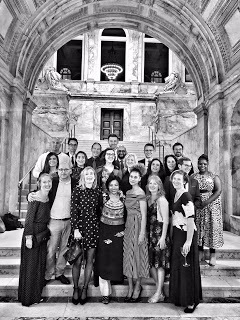 Gala Dinner at Boston Public Library
Gala Dinner at Boston Public Library
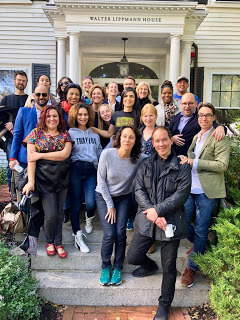 Brunch at Lippmann House
Brunch at Lippmann House
 Gala Dinner at Boston Public Library
Gala Dinner at Boston Public Library Brunch at Lippmann House
Brunch at Lippmann House
Published on October 27, 2018 20:13
September 25, 2018
Catwalking
Published on September 25, 2018 14:49
September 3, 2018
Thank you Los Angeles & Dallas: Project Anime & AnimeFest 2018
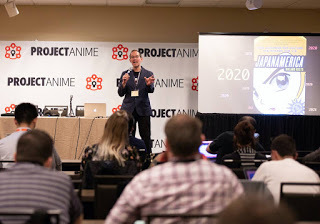 (PROJECT ANIME 2018, Westin Bonaventure Hotel, Los Angeles, CA. photo: Kumo Takeda)
(PROJECT ANIME 2018, Westin Bonaventure Hotel, Los Angeles, CA. photo: Kumo Takeda)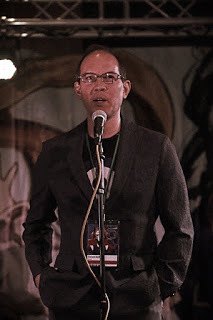 (ANIMEFEST 2018, Sheraton Dallas, Dallas, TX.)
(ANIMEFEST 2018, Sheraton Dallas, Dallas, TX.)
Published on September 03, 2018 03:53
July 23, 2018
Feminism, motherhood and anime: Mari Okada's MAQUIA
Motherhood in modern anime
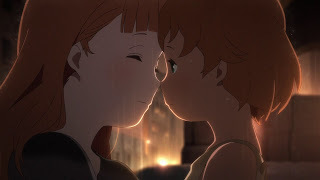 © PROJECT MAQUIA
© PROJECT MAQUIA
Screenwriter, author and newly minted anime director Mari Okada shrugs and smiles as she and her entourage burst through a door behind me 15 minutes late for our meeting. We’re in a conference room on the ground floor of The Westin Bonaventure Hotel and Suites in downtown Los Angeles, a building famous for its cameos in hit films and TV series (“True Lies,” “CSI”) and for its bewildering interior layout.
“We didn’t know there was another entrance to this room,” explains one of her handlers. Okada, sporting a floral print dress, puts a hand to her lips and emits a giggle.
It’s not what I’d expected. In her autobiography, “From Truant to Anime Screenwriter: My Path to ‘Anohana’ and ‘The Anthem of the Heart,'” recently published in English by J-Novel Club, the 42-year-old Okada tells her coming-of-age story as a rural hikikomori (shut-in) in Chichibu, Saitama Prefecture. She was awkward and unhygienic, endured sporadic bullying, got into fights with boys, dropped out of school, and was nearly knifed to death by her divorced and disapproving mother.
Self-loathing humor bleeds through the book (“Okada, you’re a failure of a human being,” she is once told and continues to remind herself), an unsparing portrait of the artist as an asocial and ill-equipped young woman.
 Mari Okada
Mari Okada
NHK is adapting Okada’s autobiography into a live-action TV special starring former AKB48 idol Atsuko Maeda and set to air in September. Okada is writing the screenplay, which will also feature footage from her anime films and series.
But that’s not why Okada is in LA. Her directorial debut, the anime feature “Maquia: When the Promised Flower Blooms,” had its U.S. premiere on July 6 at Anime Expo, North America’s largest anime convention, before it rolled out in limited release around the country last Friday. The consummate loser — who spent her youthful years hiding in her futon, wearing days-old underwear and T-shirts while ingesting a mix of manga, video games, and Camus and Tanizaki novels — has embarked on a promotional tour, stepping into the spotlight for the first time to sell her work. And when she is finally seated across from me at a small round table, she is disarmingly candid.
Read more >>
 © PROJECT MAQUIA
© PROJECT MAQUIAScreenwriter, author and newly minted anime director Mari Okada shrugs and smiles as she and her entourage burst through a door behind me 15 minutes late for our meeting. We’re in a conference room on the ground floor of The Westin Bonaventure Hotel and Suites in downtown Los Angeles, a building famous for its cameos in hit films and TV series (“True Lies,” “CSI”) and for its bewildering interior layout.
“We didn’t know there was another entrance to this room,” explains one of her handlers. Okada, sporting a floral print dress, puts a hand to her lips and emits a giggle.
It’s not what I’d expected. In her autobiography, “From Truant to Anime Screenwriter: My Path to ‘Anohana’ and ‘The Anthem of the Heart,'” recently published in English by J-Novel Club, the 42-year-old Okada tells her coming-of-age story as a rural hikikomori (shut-in) in Chichibu, Saitama Prefecture. She was awkward and unhygienic, endured sporadic bullying, got into fights with boys, dropped out of school, and was nearly knifed to death by her divorced and disapproving mother.
Self-loathing humor bleeds through the book (“Okada, you’re a failure of a human being,” she is once told and continues to remind herself), an unsparing portrait of the artist as an asocial and ill-equipped young woman.
 Mari Okada
Mari OkadaNHK is adapting Okada’s autobiography into a live-action TV special starring former AKB48 idol Atsuko Maeda and set to air in September. Okada is writing the screenplay, which will also feature footage from her anime films and series.
But that’s not why Okada is in LA. Her directorial debut, the anime feature “Maquia: When the Promised Flower Blooms,” had its U.S. premiere on July 6 at Anime Expo, North America’s largest anime convention, before it rolled out in limited release around the country last Friday. The consummate loser — who spent her youthful years hiding in her futon, wearing days-old underwear and T-shirts while ingesting a mix of manga, video games, and Camus and Tanizaki novels — has embarked on a promotional tour, stepping into the spotlight for the first time to sell her work. And when she is finally seated across from me at a small round table, she is disarmingly candid.
Read more >>
Published on July 23, 2018 03:31
July 20, 2018
With Mari Okada, anime screenwriter, author and director at Project Anime, Los Angeles
Published on July 20, 2018 04:25
With Mari Okada, feminist writer and director. MAQUIA out today in USA.
Published on July 20, 2018 04:25
July 15, 2018
With legendary mangaka Go Nagai at Project Anime, Los Angeles
Published on July 15, 2018 22:43
June 27, 2018
Japan's 'light novels' catch fire in America
Can Japanese ‘light novels’ remain publishing heavyweights?
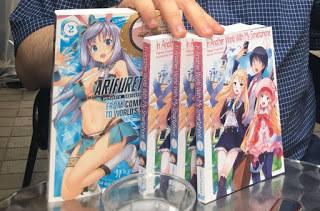 Sam Pinansky (photo: Roland Kelts)
Sam Pinansky (photo: Roland Kelts)
The palm-sized, lavishly illustrated paperbacks known in Japan as “light novels” can have some heavy titles. “That Time I Got Reincarnated as a Slime” is one. Another, “Is it Wrong to Try to Pick up Girls in a Dungeon?” is a bestseller, but so is “I Want to Eat Your Pancreas.” And that’s a love story. Of course.
They can also have some heavy political repercussions. Earlier this month, a light novel called “(New Life +) Young Again in Another World” had its big-budget anime adaptation and future publications in all languages abruptly canceled after its author, pen name Mine, was found to have posted racist tweets denigrating Chinese and Koreans. The offensive posts, first issued four years ago, were deleted, and Mine publicly apologized. But the tweets and the novel’s storyline, in which a Japanese swordsman who murdered 3,000 in China is reborn in a land of monsters, were not taken lightly.
Quite what qualifies as a light novel is a subject of debate and ongoing revision. According to translator and journalist Kim Morrissy’s 2016 Anime News Network article, Keita Kamikita, manager of an online fantasy and science fiction forum, coined the term in 1990 when he noticed that new types of fantasy prose narratives were drawing the attention of manga and anime fans. This burgeoning readership was not entirely young, so the “young adult” label didn’t apply. Nor were they reading works that adhered to pre-existing genres such as romance, mystery, horror and so on.
Read more >>
 Sam Pinansky (photo: Roland Kelts)
Sam Pinansky (photo: Roland Kelts)The palm-sized, lavishly illustrated paperbacks known in Japan as “light novels” can have some heavy titles. “That Time I Got Reincarnated as a Slime” is one. Another, “Is it Wrong to Try to Pick up Girls in a Dungeon?” is a bestseller, but so is “I Want to Eat Your Pancreas.” And that’s a love story. Of course.
They can also have some heavy political repercussions. Earlier this month, a light novel called “(New Life +) Young Again in Another World” had its big-budget anime adaptation and future publications in all languages abruptly canceled after its author, pen name Mine, was found to have posted racist tweets denigrating Chinese and Koreans. The offensive posts, first issued four years ago, were deleted, and Mine publicly apologized. But the tweets and the novel’s storyline, in which a Japanese swordsman who murdered 3,000 in China is reborn in a land of monsters, were not taken lightly.
Quite what qualifies as a light novel is a subject of debate and ongoing revision. According to translator and journalist Kim Morrissy’s 2016 Anime News Network article, Keita Kamikita, manager of an online fantasy and science fiction forum, coined the term in 1990 when he noticed that new types of fantasy prose narratives were drawing the attention of manga and anime fans. This burgeoning readership was not entirely young, so the “young adult” label didn’t apply. Nor were they reading works that adhered to pre-existing genres such as romance, mystery, horror and so on.
Read more >>
Published on June 27, 2018 22:49
June 25, 2018
Manga for intermediates -- guest post by Danica Davidson (with Rena Saiya)
With the global popularity of manga, there are also people in all corners of the globe who want to learn how to draw in the manga style. I have a background in manga – after starting out as a fan, I made it part of my career – covering it as a journalist, adapting it into English and working in the editing process. Two years after the release of my first book on manga,
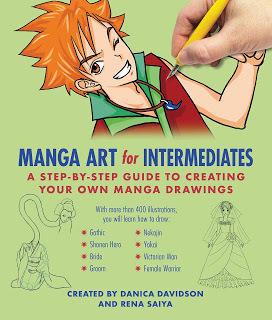
For this book I worked with Rena Saiya, a professional Japanese mangaka who is making her American debut. This book mirrors the design of the first book, which aimed to show more steps for character-drawing than your average how-to-draw book, and to also make sure that the art is in the manga style. (I find most how-to-draw manga books in America look like a combination of manga and American comics.) But the book also discusses how professional Japanese mangaka work, including what pens they use, what happens if they make a mistake, and some of what Japanese publishers look for.
I also talked with Rena for what she wanted to share with
“Thanks to the spreading popularity of manga worldwide, the development of IT technologies, and my English ability, I was able to make a decision to expand abroad while living in Japan,” she said. “This is after several years of a career in the Japanese manga industry. I thought it would be interesting if I could publish my manga books through foreign publishers directly, since usually manga sold in foreign countries are the ones first published in Japan and translated later.
“As for the content of the book, I heard that there are few manga drawing books which are based on genuine Japanese style in the States. So, I tried to put basic techniques or information which would be most common among Japanese mangaka. As for drawing tools' information, I chose ones which are available on the internet. With regards to the characters in the book, popular ones has been chosen and I tried to design a kind of typical type of each character. Therefore by learning the characters, you can create a kind of database in your head and it would be helpful when you design your original characters.”
Manga continues to grow around the world, but I’m not aware of any other books like this one, which combine the knowledge of a Japanese mangaka who knows the Japanese manga market with an American author who knows the American manga market. I think it’s a unique offering for fans of manga and can help them grow as artists. -- Danica Davidson
Manga Art for Intermediates
By Danica Davidson and Rena Saiya
Skyhorse Publishing paperback, also available as an ebook
On sale: June 2018
ISBN: 978-1510729520
Price: $19.99

For this book I worked with Rena Saiya, a professional Japanese mangaka who is making her American debut. This book mirrors the design of the first book, which aimed to show more steps for character-drawing than your average how-to-draw book, and to also make sure that the art is in the manga style. (I find most how-to-draw manga books in America look like a combination of manga and American comics.) But the book also discusses how professional Japanese mangaka work, including what pens they use, what happens if they make a mistake, and some of what Japanese publishers look for.
I also talked with Rena for what she wanted to share with
“Thanks to the spreading popularity of manga worldwide, the development of IT technologies, and my English ability, I was able to make a decision to expand abroad while living in Japan,” she said. “This is after several years of a career in the Japanese manga industry. I thought it would be interesting if I could publish my manga books through foreign publishers directly, since usually manga sold in foreign countries are the ones first published in Japan and translated later.
“As for the content of the book, I heard that there are few manga drawing books which are based on genuine Japanese style in the States. So, I tried to put basic techniques or information which would be most common among Japanese mangaka. As for drawing tools' information, I chose ones which are available on the internet. With regards to the characters in the book, popular ones has been chosen and I tried to design a kind of typical type of each character. Therefore by learning the characters, you can create a kind of database in your head and it would be helpful when you design your original characters.”
Manga continues to grow around the world, but I’m not aware of any other books like this one, which combine the knowledge of a Japanese mangaka who knows the Japanese manga market with an American author who knows the American manga market. I think it’s a unique offering for fans of manga and can help them grow as artists. -- Danica Davidson
Manga Art for Intermediates
By Danica Davidson and Rena Saiya
Skyhorse Publishing paperback, also available as an ebook
On sale: June 2018
ISBN: 978-1510729520
Price: $19.99
Published on June 25, 2018 22:00


